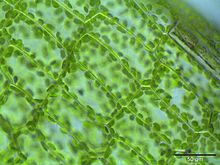Cytoplasmic streaming

This article has multiple issues. Please help improve it or discuss these issues on the talk page. (Learn how and when to remove these template messages)
|
Cytoplasmic streaming, also called protoplasmic streaming and cyclosis, is the directed flow of cytosol (the liquid component of the cytoplasm) and organelles around large fungal and plant cells. This movement aids in the delivery of organelles, nutrients, metabolites, genetic information, and other materials to all parts of the cell. Cytoplasmic streaming occurs as myosin-coated organelles move along actin filaments in the cytoskeleton of the cell, causing the cytosol to move as well.[1] Cytoplasmic streaming was first discovered in the 1830s.
Mechanism
Myosin proteins use energy of adenosine triphosphate (ATP) to act as a molecular motor, which slides along actin filaments. This works in a manner that tows the organelles and other cytoplasmic contents in the same direction. Myosin proteins consist of two conjoined proteins.
The green alga genus Chara and other genera in the Division Charophyta, such as Coleochaete, are thought to be the closest relatives of land plants.[2] These haploid organisms contain some of the largest plant cells on earth, a single cell of which can reach up to 10 cm in length. The large size of these cells demands an efficient means to distribute resources, which is enabled via cytoplasmic streaming.[3]
Cytoplasmic streaming is strongly dependent upon intracellular pH and temperature. It has been observed that the effect of temperature on cytoplasmic streaming created linear variance and dependence at different high temperatures in comparison to low temperatures.[4] This process is complicated, with temperature alterations in the system increasing its efficiency, with other factors such as the transport of ions across the membrane being simultaneously affected. This is due to cells homeostasis depending upon active transport which may be affected at some critical temperatures.
In plant cells, chloroplasts may be moved around with the stream, possibly to a position of optimum light absorption for photosynthesis. The rate of motion is usually affected by light exposure, temperature, and pH levels.
The optimal pH at which cytoplasmic streaming is highest, is achieved at neutral pH and decreases at both low and high pH.
The flow of cytoplasm may be stopped by:
- Adding Lugol's iodine solution
- Adding Cytochalasin D (dissolved in dimethyl sulfoxide)
See also
References
- ^ Woodhouse, F.G.; Goldstein, R.E. (2013), "Cytoplasmic streaming in plant cells emerges naturally by microfilament self-organization", Proceedings of the National Academy of Sciences, 110 (35): 14132–14137, doi:10.1073/pnas.1302736110
- ^ "The Whole Plant and Cell to Cell Transport, (chapter four)" (pdf). University of New South Wales. 2013-04-21. Retrieved 2013-11-05.
- ^ Woodhouse, F. G.; Goldstein, R. E. (2013). "Cytoplasmic streaming in plant cells emerges naturally by microfilament self-organization". Proceedings of the National Academy of Sciences. 110 (35): 14132. doi:10.1073/pnas.1302736110.
- ^ Shimmen, T.; Yokota, E. (2004). "Cytoplasmic streaming in plants". Current Opinion in Cell Biology. 16 (1): 68–72. doi:10.1016/j.ceb.2003.11.009. PMID 15037307.
Sources
- Riddle, Donald L; Blumenthal, Thomas; Meyer, Barbara J; et al., eds. (1997). "Section III: Establishment of Polarity in the One-Cell Embryo". C. elegans II (2nd ed.). Cold Spring Harbor (NY: Cold Spring Harbor Laboratory Press. ISBN 0-87969-532-3.
{{cite book}}: External link in|chapterurl=|chapterurl=ignored (|chapter-url=suggested) (help) - Lodish, Harvey; Berk, Arnold; Zipursky, S Lawrence; Matsudaira, Paul; Baltimore, David; Darnell, James (2000). "Figure 18-40 Cytoplasmic streaming in cylindrical giant algae". Molecular Cell Biology (4th ed.). New York: W. H. Freeman. ISBN 0-7167-3136-3.
{{cite book}}: External link in|chapterurl=|chapterurl=ignored (|chapter-url=suggested) (help) - Lodish 2000, Section 18.5: Actin and Myosin in Nonmuscle Cells
